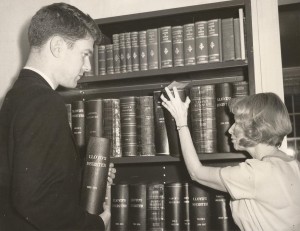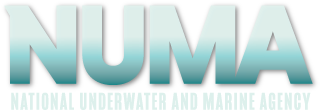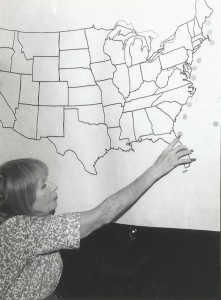The Wreck Lady: She Will Have Shipwrecks Wherever She Goes

Jean Haviland pulls out one of the 133 bound volumnes of Lloyd’s Register of Shipping for diver Bill Scheibel. Photo by Ellsworth Boyd.
Dr. Joe Shockley of Miami, Florida, asked about the late Jean Haviland who was one of the country’s foremost authorities on shipwrecks. It was Mrs. Haviland who sparked my interest in shipwrecks when she and her late husband, Ken, opened their home and extensive library to me. I will be forever grateful to them for their kindness and expert advice. The Havilands (who married late in life and had no children) lived in a two-bedroom apartment in Baltimore, Maryland, and had to rent an adjoining apartment to house their growing collection. And what a collection it was!
Shelved on one wall, from floor to ceiling, stood 133 bound volumes of Lloyd’s Register of Shipping. Across the room, next to a sizeable set of Brassey’s Naval Annual, stood a glass-enclosed bookcase containing fifty-nine volumes of Fred James’ All the World’s Fighting Ships. A massive filing cabinet housing 41,000 ship photographs and 20,000 pictures, illustrations and drawings rested against another wall. Framed pictures of clipper ships, steamships, naval vessels and shipwrecks hung in what little space that remained on the walls. The mantel over the fireplace displayed a ship’s clock, a miniature anchor and a deep-sea diver.
The collection also included ship-owners’ reprints referred to as “redbooks” and underwriters’ “greenbooks”—all references to ships that sailed as far back as 1823. A thick book, “Underwriters’ Registry for Iron Vessels,” was one of only four copies in existence. Two museums and the Library of Congress house the other three. Jean also had a dozen six-foot-tall filing cabinets filled with scrapbooks about ships and shipwrecks. She began cutting and pasting these newspaper and magazine clippings when she was nine years old!
Ken, a retired Johns Hopkins University professor, spent much of his time researching steam navigation in early times, while Jean became the “Wreck Lady.” As her name got around, she responded to hundreds of requests about shipwrecks from divers all over the world. Bill Scheible, formerly of the Maryland Hydronauts Club, asked about an unidentified ship with triple props that lay upside-down in waters off the New Jersey coast. Jean immediately eliminated sunken freighters since none of them sported triple screws. She knew that some icebreakers and ocean liners had them, but none were known to have sunk off the Jersey coast. After many hours of research, she found an ocean liner that had been converted to a troop ship in 1917. Bill was elated when he got the entire tragic story of the troop transport, NORTHERN PACIFIC.
Not long after I met Jean, I visited an interesting wreck off Key Largo, Florida, that was listed on nautical charts as the U.S.S. BRENTWOOD. It’s no wonder I couldn’t find anything about it in my attempts to research the vessel. It didn’t take Jean long to find its correct name, the M/V BENWOOD, a Norwegian freighter that sank in 1942 after colliding with the tanker, ROBERT C. TUTTLE. This was an instance, as were many others, when she left no stone unturned in her meticulous searches for elusive shipwrecks. I learned a lot from Jean and when she passed at age 84, I felt a great loss, as did many others whom she helped. Ken, also a sad loss to co-workers, relatives and friends, had passed six year’s earlier at age 87. The couple left their entire collection to two museums: The Mariner’s Museum, Newport News, Virginia, and The Peabody Museum, Salem, Massachusetts.
8 Comments
Submit a Comment
All Rights Reserved © | National Underwater and Marine Agency
All Rights Reserved © | National Underwater and Marine Agency
Web Design by Floyd Dog Design
Web Design by Floyd Dog Design


This certainly make my research look like a minor hobby. Thanks for the great article Professor. This fishing boat I am trying to drag is giving me nothing but trouble.
Thanks for your kind comments Ethan. I had the pleasure and opportunity of using the Havilands’ vast libary from time to time. They didn’t live far from me. We went out socially as well. They were a wonderful couple and I miss them. Good luck with your boat. Keep me posted on your progress.
Why did the Haviland collection go to two different marine museum libraries and how did they determine how to split it up? I enjoyed the article. You must have had a vast amount of books, papers and photos at your disposal for research of shipwrecks worldwide.
The Havilands conducted research their entire lives and at least twice a year traveled to the Peabody-Essex Museum in Salem, MA and to the Mariner’s Museum in Newport News, Virginia. They didn’t want to slight one over the other so they split the collection between the two museums. Their collection was large and each museum got plenty of books, papers, photos, etc. Yes, I did have a big advantage being afforded the opportunity to visit the Havilands and use their vast resources. They were very helpful, especially Jean who was the Shipwreck Lady. I spent many hours going through her scrapbooks on ships and shipwrecks. Thanks for writing.
I enjoyed your article about Mrs. Jean Haviland, the Shipwreck Lady. Of all the shipwrecks you wrote about as you used Mrs. Haviland’s library, which one was your favorite?
I always enjoyed reseachng the Titanic when I went to Jean’s and Ken’s library. She had so much information on it and I always discovered something new. But my true favorite was researchng the Benwood, inaccurately named the Brentwood on nautical charts, which Jean pointed out to me. It’s a freighter sunk during WWII off the Florida Keys. It has an interestng history and eventually I did have an opportunity to dive it. That was some years ago and divers still like to dive it today.
I knew the Havilands from their summers spent in Maine.
I have some of Jean’s wreck-related things that may be of interest to Mr. Boyd.
Thank you. No, I hadn’t planned on a second article. Jean and Ken Haviland were dear friends and I was happy to write about them. They were wonderful people and world class experts on ships and shipwrecks.